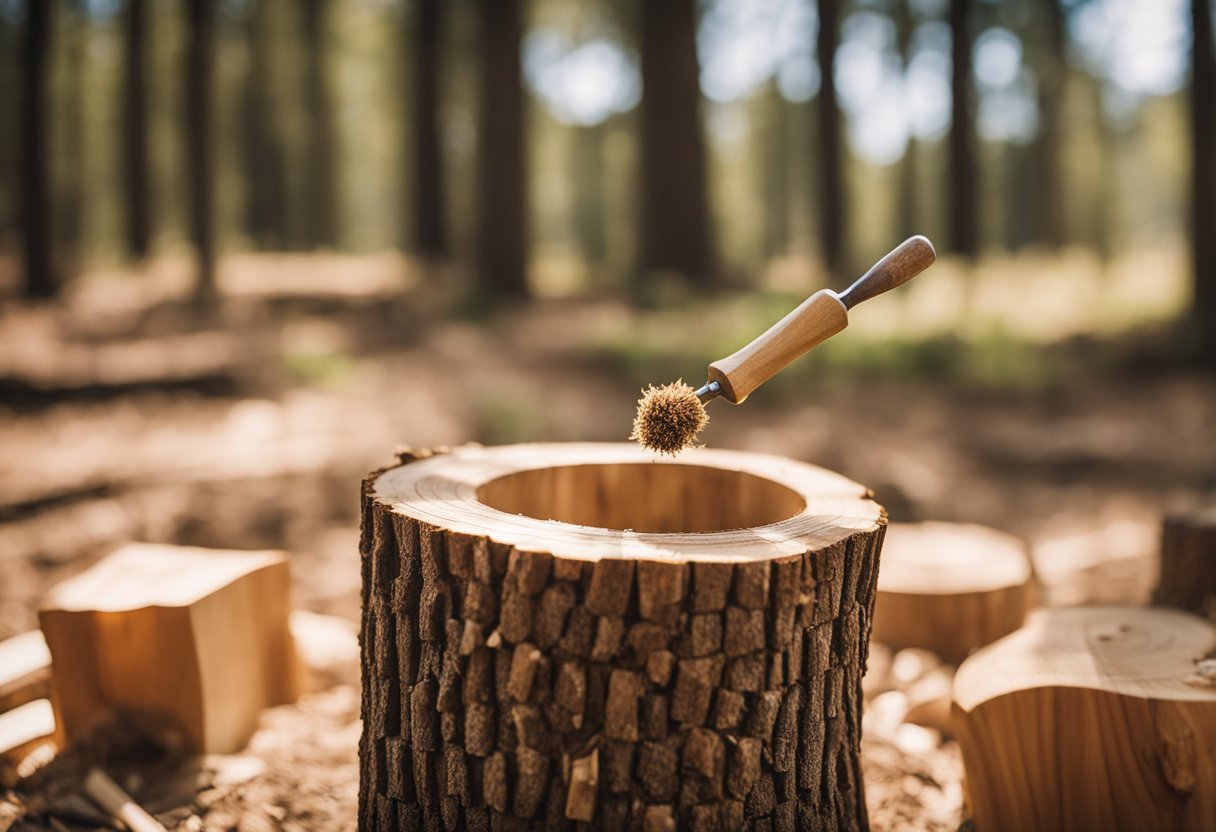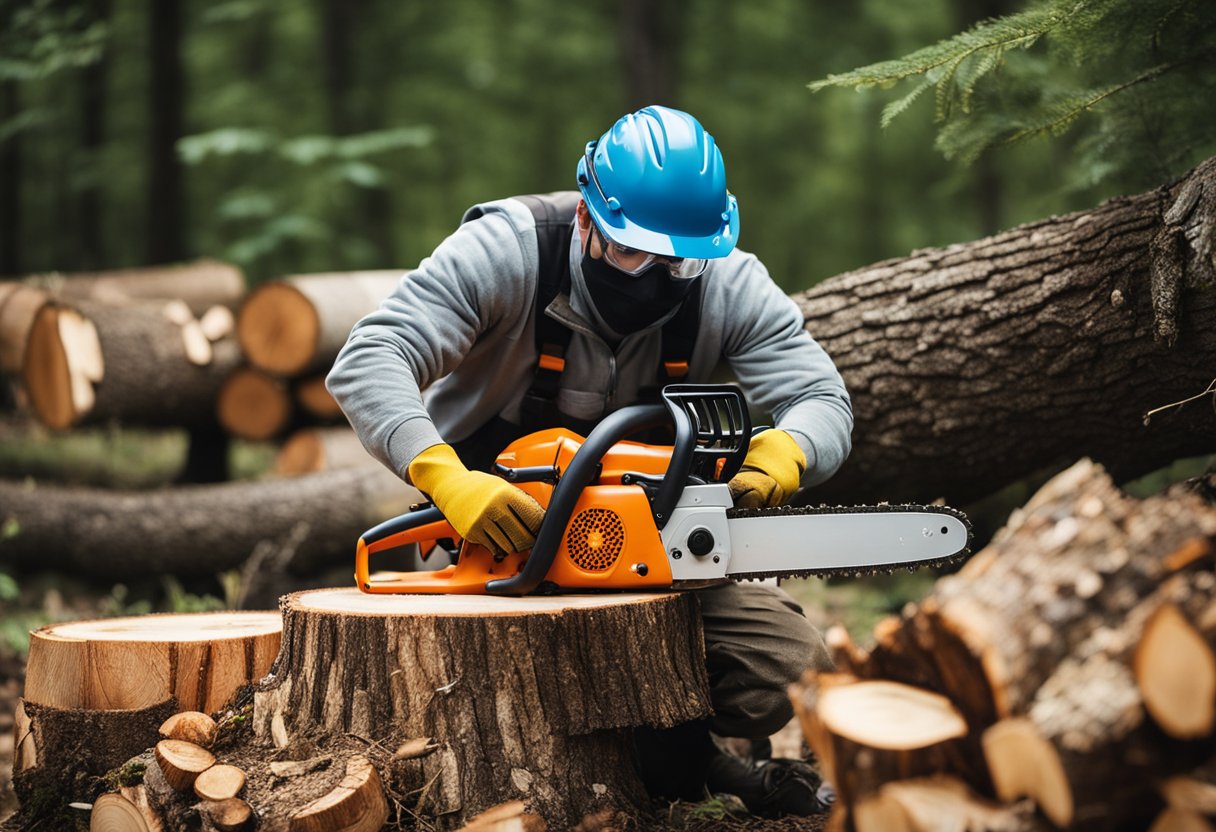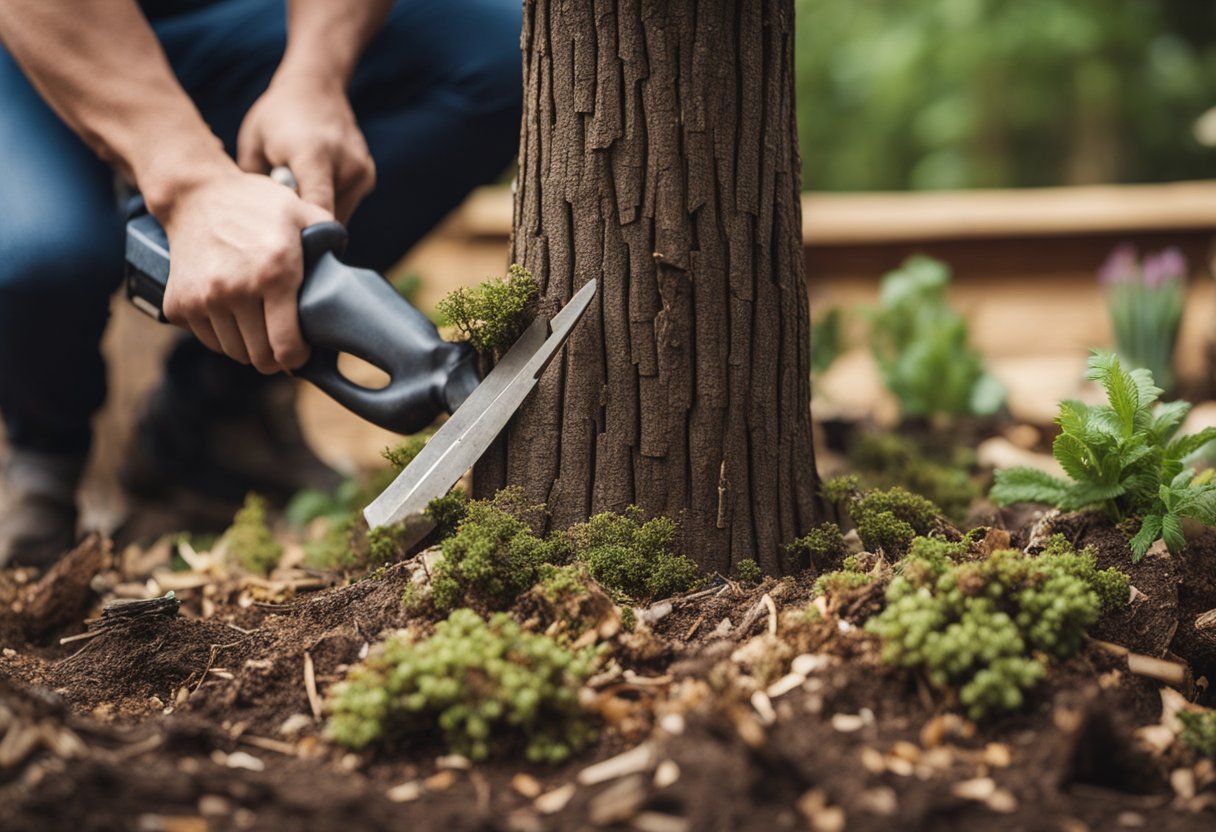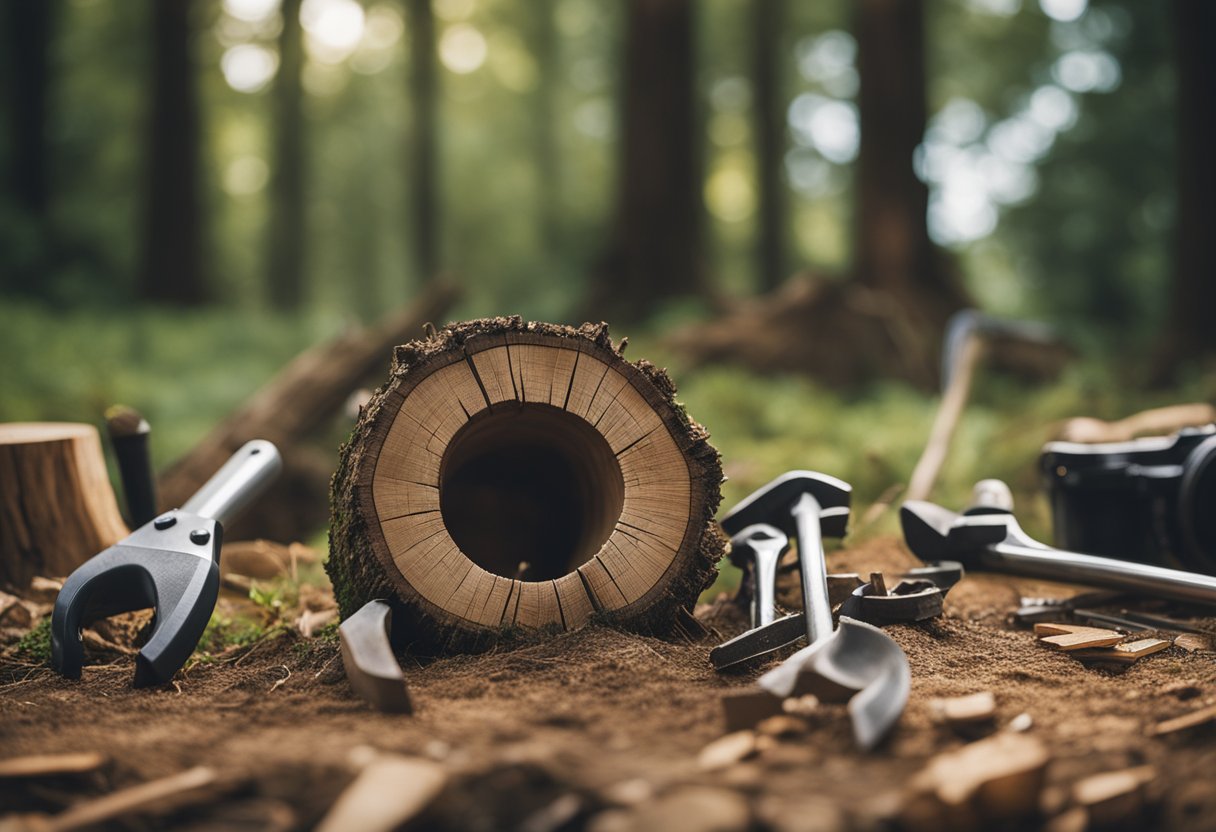Hollowing out a tree stump is a great way to repurpose an old tree stump and turn it into a beautiful decoration piece for your garden. Whether you want to create a planter, a birdhouse, or just a unique piece of art, hollowing out a tree stump is a fun and rewarding project that anyone can do. In this article, I will guide you through the process of hollowing out a tree stump, step by step.

Before we begin, it’s important to note that hollowing out a tree stump can be dangerous, especially if you’re using power tools like a chainsaw. Therefore, safety should always be your top priority. Make sure you wear protective gear like safety glasses, gloves, and a dust mask. Also, make sure you have a first-aid kit nearby, just in case. With that said, let’s get started!
Key Takeaways
- Always prioritize safety when hollowing out a tree stump.
- Depending on the method you choose, you may need different tools and materials.
- Hollowing out a tree stump can be a fun and rewarding project that allows you to repurpose an old tree stump in creative ways.
Safety Precautions

When hollowing out a tree stump, safety should always be the top priority. Here are a few safety precautions to keep in mind before starting the process:
1. Wear Protective Gear
Wearing proper protective gear is essential to prevent any injuries. Gloves, goggles, and a face shield are recommended to protect your hands, eyes, and face from flying debris. Long-sleeved shirts and full-length pants are also sensible attire to wear.
2. Choose the Right Tools
Using the right tools can make a big difference when it comes to safety. A chainsaw, drill, hammer, ax, power drill, and carving tools are often used when hollowing out a tree stump. Make sure that the tools you choose are in good condition and are appropriate for the job.
3. Clear the Work Area
Clearing the work area of any obstacles and debris can help prevent accidents. Make sure that the area around the tree stump is free of any tripping hazards and that there is enough space to move around.
4. Follow Proper Techniques
Following proper techniques when using tools can help prevent injuries. For example, when using a chainsaw, make sure to hold it with both hands and keep it away from your body. When using a drill, make sure to use the right size drill bit and drill at a slow speed.
By following these safety precautions, you can help ensure a safe and successful process of hollowing out a tree stump.
Tools and Materials Needed
To hollow out a tree stump, you will need the following tools and materials:
Chainsaw
A chainsaw is the most efficient tool for cutting through the tough exterior of a tree stump. It is ideal for removing large chunks of wood quickly and easily. When using a chainsaw, make sure to wear protective gear such as goggles, gloves, and a dust mask.
Power Drill
A power drill is essential for creating holes in the tree stump. You will need a 1-inch spade bit with a spade bit extension to drill evenly spaced holes around the perimeter of the stump. Make the holes about 12 inches deep and three to four inches back from the edge.
Chisel and Hammer
A chisel and hammer are useful for removing the wood between the drilled holes. You can use a chisel to create a rough outline of the hollowed-out area, and then use a hammer to remove the wood.
Wood Carving Gouge
A wood carving gouge is a useful tool for shaping the inside of the tree stump. It is ideal for creating smooth curves and removing any remaining wood.
Auger Bit
An auger bit is useful for creating larger holes in the tree stump. You can use it to remove larger chunks of wood and make the hollowing process faster.
Nails and Screws
Nails and screws can be used to secure the tree stump to the ground, preventing it from moving while you work on it.
Sandpaper
Sandpaper is useful for smoothing out the inside of the tree stump. It is ideal for removing any rough edges and creating a smooth finish.
Hoe and Mallet
A hoe and mallet are useful for removing the debris from inside the tree stump. You can use the hoe to scoop out the wood chips and the mallet to tap the stump and remove any remaining debris.
By using the right tools and materials, you can easily hollow out a tree stump and turn it into a decorative item for your backyard.
Hollowing Out the Stump
To hollow out a tree stump, there are several methods you can use. The most common methods are drilling holes, using fire, and manual labor. Each method has its own advantages and disadvantages, so it’s important to choose the right method for your needs.
Drilling Holes
Drilling holes is the most common method for hollowing out a tree stump. To do this, you will need a drill and a large drill bit. First, soften the wood by waiting a day after a rainstorm, when the timber will be softer and more malleable. Then, drill holes across the stump area that will be hollowed out. Throughout the segment, space the holes a few inches apart. This will make it easier to remove the wood from the stump.
Using Fire
Another method for hollowing out a tree stump is to use fire. This method is more time-consuming than drilling holes, but it can be more effective. To do this, you will need to create a fire in the center of the stump. The fire will burn the wood inside the stump, making it easier to remove. However, this method can be dangerous, so it’s important to take the necessary precautions.
Manual Labor
Manual labor is the most time-consuming method for hollowing out a tree stump. However, it is also the most effective. To do this, you will need to use a chisel and a mallet to remove the wood from the stump. This method requires a lot of patience and effort, but it can be very rewarding.
Once you have hollowed out the stump, it’s important to smooth the edges to make it safe and attractive. You can use sandpaper or a chisel to do this. Finally, you can use the hollowed-out stump for various purposes, such as a planter, a decorative centerpiece, or even a seating element.
Creating the Planter
Once the tree stump has been hollowed out, it’s time to create the planter. First, it’s important to consider drainage. While it’s not necessary to have drainage holes, it will certainly help the stump last longer and prevent any possible issues with root rot later on if plants become overly saturated. Therefore, I recommend drilling a few drainage holes in the bottom of the stump using a drill bit.
Next, add a layer of gravel to the bottom of the stump. This will help with drainage and prevent soil from clogging the drainage holes. On top of the gravel, add a layer of potting soil. The amount of soil you’ll need will depend on the size of the stump and the plants you plan to use.
Once the soil is in place, it’s time to add your plants. When choosing plants for your tree stump planter, consider the size of the stump and the amount of sunlight it receives. Ferns and shade-loving plants are great options for shady areas, while flowers and other sun-loving plants can thrive in areas that receive more sunlight.
After planting, top off the planter with a layer of mulch. This will help retain moisture and keep the soil in place. You can also add some compost to the top layer of soil to provide additional nutrients for your plants.
Overall, creating a planter from a tree stump is a great way to add some unique and natural charm to your garden. With proper drainage, soil, and plant selection, your tree stump planter can thrive for years to come.
Maintaining the Planter

Once you have successfully hollowed out a tree stump and planted your desired plants, it is important to maintain the planter to ensure the plants continue to thrive. Here are some tips on how to maintain your tree stump planter.
Watering
Water is essential for plants to grow, and it is important to water your tree stump planter regularly. The amount of water required will depend on the type of plants you have planted, the weather conditions, and the size of the planter. It is important not to overwater the plants as this can lead to root rot. You can use a watering can or a hose with a gentle spray to water the plants.
Rain and Rainstorms
Rain is a natural source of water for plants, and it can help to replenish the moisture in the soil. However, heavy rain or rainstorms can cause damage to the plants. If you know that a heavy rainstorm is coming, you can cover the planter with a tarp or a plastic sheet to protect the plants.
Air Filtration
Plants need fresh air to grow, and it is important to ensure that the planter has adequate air circulation. You can prune the plants regularly to remove any dead or damaged leaves, which can improve air circulation. You can also use a fan to improve air circulation around the planter.
Pests and Insects
Pests and insects can damage the plants and reduce their growth. You can use insecticides or pesticides to control pests and insects. However, it is important to choose the right product and follow the instructions carefully. You can also use natural methods such as introducing beneficial insects like ladybugs or using neem oil.
Bacteria and Fungi
Bacteria and fungi can cause diseases in plants, and it is important to prevent their growth. You can use a fungicide or bactericide to control the growth of bacteria and fungi. You can also use natural methods such as compost tea or a compost pile to introduce beneficial microorganisms that can help to prevent the growth of harmful bacteria and fungi.
Nutrients
Plants require nutrients to grow, and it is important to ensure that the soil in the planter has adequate nutrients. You can use a fertilizer to provide the necessary nutrients to the plants. However, it is important to choose the right fertilizer and follow the instructions carefully. You can also use natural methods such as adding compost or mulch to the soil to provide nutrients to the plants.
By following these tips, you can ensure that your tree stump planter remains healthy and your plants continue to thrive.
Additional Creative Uses
Once you have hollowed out a tree stump, there are many creative ways to repurpose it in your backyard. Here are some ideas to get you started:
-
Gnome Home: Create a whimsical gnome home by adding a door and windows to the hollowed-out tree stump. You can also add a small garden around the stump to create a magical fairy garden.
-
Stool: Turn the hollowed-out tree stump into a unique and rustic stool. Simply add legs or a base to the bottom of the stump and sand the top for a smooth surface. This can be a great addition to your backyard seating area.
-
Board Game: Use the hollowed-out stump as a base for an outdoor board game such as chess or checkers. Paint the top of the stump with the game board and use stones or other objects as game pieces.
-
Birdbaths: Turn the hollowed-out stump into a birdbath by adding a shallow bowl or plate to the top of the stump. This can be a great addition to your backyard landscape and provide a focal point for birds to gather.
-
Seating: Turn the hollowed-out stump into a unique seating area by adding a cushion or seat to the top of the stump. This can be a great addition to your backyard seating area and provide a natural and rustic feel.
-
Pedestal: Use the hollowed-out stump as a pedestal to display a statue or other decorative object in your backyard. This can be a great addition to your backyard landscape and provide a focal point for your garden.
Overall, there are many creative ways to repurpose a hollowed-out tree stump in your backyard. With a little creativity and imagination, you can turn a simple stump into a functional and beautiful addition to your outdoor space.
Preserving the Hollowed Stump
Preserving the hollowed stump is an important step to ensure that it remains intact and free from rot, pests, and moisture. Here are some effective ways to preserve the hollowed stump:
Charcoal
Charcoal is an excellent natural preservative that can help to eliminate moisture and prevent rot. Simply place a layer of charcoal inside the hollowed stump and cover it with a piece of plastic or tarp. This will create a barrier that prevents moisture from entering the stump and causing decay.
Activated Charcoal
Activated charcoal is another great natural preservative that can help to eliminate moisture and prevent rot. It is more effective than regular charcoal because it has a larger surface area, which means it can absorb more moisture. Simply place a layer of activated charcoal inside the hollowed stump and cover it with a piece of plastic or tarp.
Potassium Nitrate
Potassium nitrate is a chemical compound that can be used to preserve the hollowed stump. It works by inhibiting the growth of fungi and bacteria that can cause decay. Simply mix a small amount of potassium nitrate with water and apply it to the inside of the hollowed stump. Allow it to dry before covering the stump with a piece of plastic or tarp.
Moisture
Moisture is the enemy of a preserved stump, so it’s important to keep it as dry as possible. Cover the top of the stump with a piece of plastic or tarp to prevent rainwater from entering the hollowed section. Additionally, make sure to remove any standing water that may accumulate inside the stump.
By following these simple steps, you can preserve your hollowed stump for years to come.
Frequently Asked Questions

What tools are needed to hollow out a tree stump for planting?
To hollow out a tree stump for planting, you will need a few tools, including a chainsaw, a drill with a spade bit, a pry bar, and a shovel. The chainsaw is used to cut off the top of the stump, while the drill with a spade bit is used to create holes in the stump. The pry bar is used to pry out the pieces of wood that have been cut, and the shovel is used to remove the debris.
How long does it take to hollow out a tree stump?
The time it takes to hollow out a tree stump depends on the size of the stump and the tools you are using. It can take anywhere from a few hours to a few days to hollow out a tree stump.
Can a chainsaw be used to hollow out a tree stump?
Yes, a chainsaw can be used to cut off the top of the tree stump, but it is not recommended to use it to hollow out the stump. A chainsaw can be dangerous to use in confined spaces, and it can be difficult to control the depth of the cut.
What are some safety precautions to take when hollowing out a tree stump?
When hollowing out a tree stump, it is important to take safety precautions. Wear protective gear such as gloves, goggles, and a face shield to prevent debris from flying into your face. Long-sleeved shirts and full-length pants are also recommended. Ensure that you remove all flammable materials around the tree stump you will be working on.
Is it possible to hollow out a tree stump without power tools?
Yes, it is possible to hollow out a tree stump without power tools. One method is to use a chisel and hammer to chip away at the wood. This method is time-consuming and requires a lot of effort, but it can be done.
What are some creative ways to use a hollowed-out tree stump as a planter?
A hollowed-out tree stump can be used as a planter in many creative ways. You can fill it with soil and plant flowers or herbs, or you can use it as a base for a birdhouse or a garden statue. Another idea is to turn it into a fairy garden by adding miniature plants and figurines. The possibilities are endless!

Hi, I’m Sal Muller of Tooltrip.com. My DIY experience led me to understand essential power tools for home projects. Tooltrip.com guides enthusiasts and professionals in choosing right tools for any job. I provide concise top tool reviews for easier, efficient DIY.

